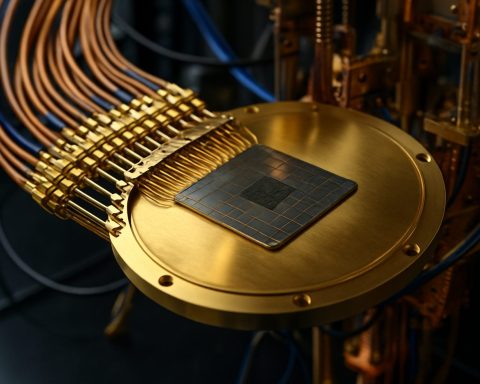- Intel Corp. faces challenges with a 6% sales drop and a $0.46 per share loss but aims for transformation and innovation.
- The company’s foundry division targets a $5.8 billion deficit transformation, aspiring to compete with industry leaders like TSMC and Samsung.
- Key to Intel’s strategy is the advancement of cutting-edge process nodes, including Intel 4, Intel 3, and future Intel 20A and 18A nodes.
- Intel focuses on RibbonFET and PowerVia technologies to gain a lead in chip design and manufacturing.
- The data center and AI sectors show growth, but Intel faces competition from NVIDIA in AI and AMD in processors.
- To counter competition, Intel accelerates AI chip development and strengthens strategic alliances in the cloud.
- Intel aims for a $40 per share target by 2025 through strategic segmentation and potential acquisitions in 5G and edge computing.
Dark clouds hover over Intel Corp., yet within its walls, an electrifying transformation gears up to rewrite the narrative of the semiconductor titan. The company finds itself wrestling with a 6% drop in sales and a chilling $0.46 per share loss. However, in the face of adversity, Intel charts a daring path — a testament to bold visions and audacious ambitions. The coming years are poised to test whether this tech giant can reclaim its crown in the cutthroat world of semiconductors.
Amidst spiraling figures, Intel isn’t scaling down but instead igniting a fire of innovation. Its foundry division, grappling with a staggering $5.8 billion deficit, undergoes a profound metamorphosis, aiming to become a self-sufficient behemoth. Intel’s vision stretches beyond mere survival, with dreams of rivaling industry stalwarts like TSMC and Samsung looming large on the horizon.
Key to Intel’s resurgence is its unfaltering bet on cutting-edge process nodes. By fast-tracking Intel 4 and Intel 3, along with futuristic Intel 20A and 18A nodes primed for 2025, the company lays the groundwork for technological supremacy. These nodes, integrating breakthrough RibbonFET and PowerVia technologies, spotlight Intel’s commitment to leading in chip design and manufacturing.
As the company fortifies its foundry ambitions, a crucial battlefront unfolds in the data center and AI segments. A glimmer of growth shone through Intel’s 9% revenue rise here, yet lurking challenges, particularly in AI, persist. The tech industry’s seismic shift towards GPU-driven AI lets NVIDIA take the lead while AMD chisels its niche with EPYC processors.
To counter this, Intel eyes an accelerated development of its AI chip lineup and builds strategic alliances with cloud behemoths. Strengthening its Gaudi AI accelerator range could be a masterstroke against NVIDIA’s dominance. Meanwhile, the Xeon processors hold the fort in data centers, pivoting towards the next-gen with efficiency and security front and center.
Intel’s strategic segmentation — dissection of its operational pie into distinct slices — tantalizes both investors and analysts. Each segment, from foundry to AI, reveals a transparent vista of potential, guiding Intel toward a target of $40 per share by 2025.
This pivotal era in Intel’s history is both a colossal gamble and a breathtaking chance. It hinges on deft navigation of the market’s turbulent waters and the fearless pursuit of innovation. From government backing to strategic acquisitions in 5G and edge computing, Intel harnesses every tool available.
As Intel embarks on this high-stakes endeavor, it stands before an industry and a world that waits, with bated breath, to witness if legacy and innovation can coalesce into a monumental comeback.
Intel’s Bold Transformation: Can It Reclaim Its Semiconductor Crown?
Intel’s Visionary Path to Reinvent the Semiconductor Market
As Intel Corporation faces financial challenges with a 6% drop in sales and a $0.46 per share loss, the tech titan is embarking on an ambitious journey to reinvent itself and reclaim its position as a leader in the semiconductor industry. This article explores the depths of Intel’s strategic initiatives as it seeks to navigate the turbulent market landscape and foster innovation.
How Intel Plans to Reignite Growth
Intel’s response to adversity is an aggressive push towards innovation rather than retreat. Here are the key strategies Intel is deploying:
1. Foundry Transformation:
– Intel is driving a metamorphosis in its foundry division, aimed at eliminating its current $5.8 billion deficit. The goal is to rival prominent entities in the foundry segment like TSMC and Samsung.
2. Process Node Advancement:
– The introduction of advanced process nodes such as Intel 4, Intel 3, and future nodes like Intel 20A and 18A by 2025 is at the forefront of their strategy. These nodes integrate groundbreaking technologies like RibbonFET and PowerVia.
3. AI and Data Center Growth:
– Intel is making strides in the AI sector with a 9% increase in revenue. This includes improving their AI chip lineup and creating partnerships with key cloud companies. Strengthening their Gaudi AI accelerators is crucial to competing with NVIDIA.
4. Strategic Segmentation:
– By breaking down its operations into segments such as foundry and AI, Intel provides transparency and potential growth avenues, aiming for a target share price of $40 by 2025.
Real-World Use Cases and Market Outlook
– AI and Data Centers:
Intel’s Xeon processors continue to serve as robust solutions for data centers, focusing on enhancing efficiency and security. The push towards AI aligns with the industry’s move towards GPU-driven architectures, but Intel’s distinct approach could see it capturing a significant market share.
– Emerging Technologies:
The company’s investment in 5G and edge computing, alongside strategic acquisitions, positions it well to capitalize on the rapid growth anticipated in these sectors.
Expert Insights and Predictions
According to industry experts, Intel’s success hinges on its ability to execute these aggressive plans while maintaining customer trust and technological edge. The tech giant’s push into AI and foundry services, if successful, could significantly disrupt current market dynamics dominated by NVIDIA and TSMC.
Actionable Recommendations for Investors and Tech Enthusiasts
1. Stay Updated on Process Innovations:
– Keep abreast of Intel’s developments in its cutting-edge process nodes, as these will be critical to assessing the company’s long-term competitiveness.
2. Monitor AI Segment Growth:
– Watch Intel’s AI market strategies and partnerships with cloud service providers, which could redefine their positioning in the sector.
3. Consider Diversified Technology Investments:
– While Intel has promising initiatives, balancing investment with other emerging technologies and companies could provide a buffer against potential market volatility.
Conclusion
Intel stands at a crossroads where legacy meets innovation. Its audacious plans to transform its foundry operations, advance process nodes, and make significant strides in AI could redefine the semiconductor industry. However, this is contingent on successfully navigating current challenges and delivering on its ambitious promises.
For those interested in further information, explore [Intel](https://www.intel.com). Keep an eye on industry trends, strategic partnerships, and technological advancements which will shape the future of the semiconductor sector.






